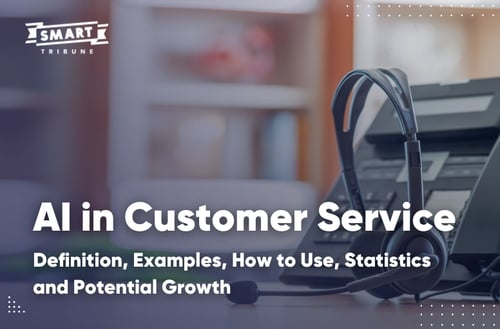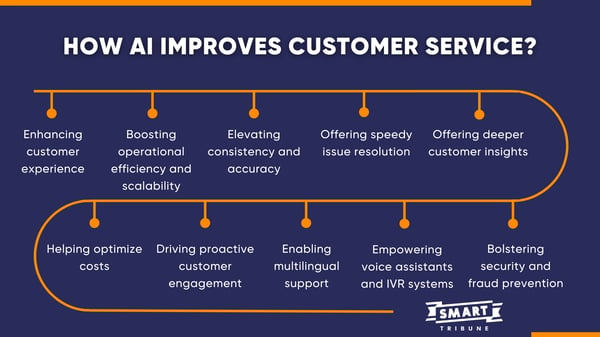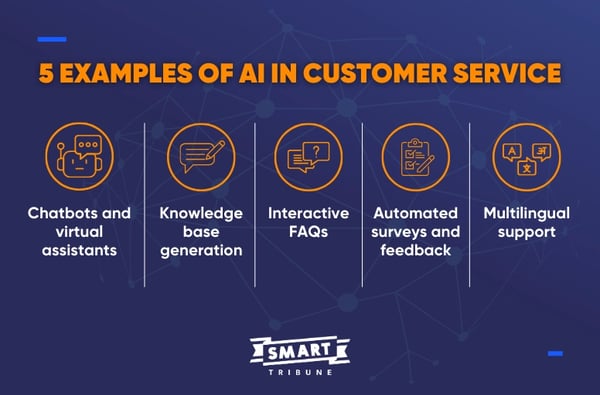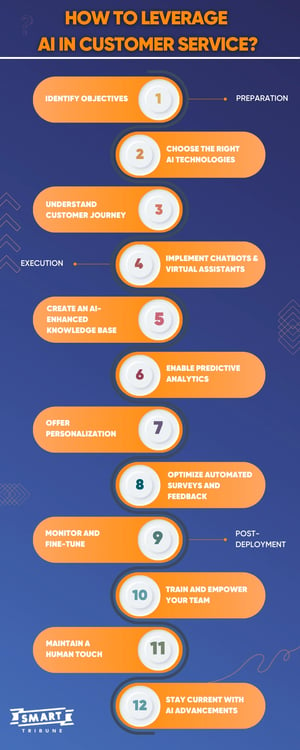
On SEPTEMBER 13, 2023
Generative AI in Customer Service | Definition, Examples, How to Use, Statistics and Potential Growth
In the ever-evolving landscape of customer service, technological innovation is taking center stage: Generative AI. This groundbreaking technology promises to reshape how businesses interact with their customers. In this article, Smart Tribune will be walking you through the transformative power of generative AI in customer service, exploring:
- Definition of generative AI,
- Benefits of AI in customer service,
- Use cases of AI in customer service,
- How to use AI in customer service,
- Eye-opening statistics on AI in customer service,
- Frequently asked questions about use of AI for digital engagement.

What is Generative AI?
Generative AI is a type of artificial intelligence that focuses on generating content or data that is original and creative, rather than simply processing and interpreting existing data. Generative AI models, such as GPT (Generative Pre-trained Transformer), are designed to generate text, images, audio, or other types of content.
Generative AI models are trained on massive datasets and learn patterns, context, and relationships within the data. They can then generate content that is coherent and contextually relevant, making them valuable for various applications
In customer service, generative AI generates human-like responses and interactions for customer support purposes.
How AI Improves Customer Service?
AI is fundamentally reshaping the landscape of customer service, offering a plethora of benefits that business owners, decision-makers, and C-level executives should consider to stay competitive and thrive in the digital era. Let's zoom in on the details.
AI enhances customer experience
AI-powered systems provide a highly personalized experience to each customer. By analyzing vast amounts of data, AI tailors recommendations, responses, and interactions to individual preferences, making customers feel valued and understood.
Furthermore, AI-driven chatbots and virtual assistants offer 24/7 availability, ensuring customers can get assistance at any time, which significantly improves their overall experience.
AI boosts operational efficiency and scalability
AI automates routine and repetitive tasks, freeing up human agents to focus on more complex and value-added interactions. Leading companies invest in AI development services to streamline these automation processes and maximize their operational effectiveness. This not only enhances efficiency but also reduces operational costs.
Additionally, AI is highly scalable and capable of handling a large volume of customer inquiries simultaneously. Businesses can easily manage fluctuations in demand without the need to hire additional staff, resulting in a more agile and cost-effective operation.
AI elevates consistency and accuracy
AI systems provide consistent responses to customer queries, reducing the risk of human errors and ensuring uniform service quality across all interactions. Moreover, AI's ability to process and analyze vast datasets with precision leads to accurate insights and data-driven decision-making.
AI puts forward speedy issue resolution
AI delivers immediate solutions to common issues, cutting wait times and enhancing issue resolution times.
Chatbots, or customer service chatbots, in particular, are adept at guiding customers through step-by-step troubleshooting processes, helping customers resolve problems quickly and efficiently.
Instant support is definitely potent, especially, when the sales team has to deal with an angry customer. Prompt answers or relevant solutions take center stage in calming down difficult customers. In the meantime, the sales rep can look for other more adequate remedies.
AI offers deeper customer insights
AI processes and analyzes extensive customer data, unveiling valuable insights into trends, preferences, and pain points. These insights empower businesses to make data-driven decisions, adapt their products and services, and refine their customer service strategies for better alignment with customer needs.
AI helps optimize costs
AI reduces workforce requirements by automating routine tasks, leading to significant cost savings in labor and training expenses. Moreover, operational efficiency improvements achieved through AI contribute to overall cost efficiency.

According to a McKinsey study, knowledge management using AI can help reduce onboarding and training costs by up to 25%. AI-powered knowledge bases provide quick access to information, reducing the need for extended training periods.
Check out more knowledge-base-related posts:
- The Basics of Creating and Managing a Knowledge Base
- Guide, Tips and Templates for Effective Knowledge Base Article
- Top 100+ Best Knowledge Base Examples
- How to Close Knowledge Gaps at The Workplace?
AI drives proactive customer engagement
AI-powered predictive analytics anticipate customer needs and behaviors, enabling proactive engagement with offers, information, or support. Automated outreach based on predictive data enhances customer engagement and loyalty.
For instance, with the empowerment of AI, Smart Push can anticipate your customers' behavioral patterns in certain areas at a certain time to proactively push personalised notifications or custom support messages that can improve customer retention, at any point along the customer journey.
Learn more:
- 5 Effortless Steps to Create A Killing Buyer Journey Map
- The Ins and Outs of Customer Journey Touchpoints
AI enables multilingual support
AI-driven chatbots can communicate with customers in multiple languages, extending a company's reach to a global audience and catering to a diverse customer base effectively.
Find out how multilingual chatbots work and how to make full use of them.
AI empowers voice assistants and IVR systems
It's no doubt that voice bots are the future of customer service. Virtual voice agents and interactive voice response (IVR) systems provide automated support over the phone, delivering efficient self-service options to customers while reducing call center costs.
AI bolsters security and fraud prevention
AI algorithms detect unusual patterns of behavior or transactions, enhancing security by preventing fraud and safeguarding customer accounts.
Doubtlessly, businesses that embrace AI in customer service gain a competitive advantage. They differentiate themselves by offering superior, AI-driven customer experiences, attracting and retaining more customers. Moreover, they position themselves for future success as AI technology continues to advance, ensuring their customer service capabilities remain at the forefront of innovation.
Realising the exponential growth potential of generative AI in customer service, Smart Tribune has integrated the automatic generation of pre-responses based on GPT-3 in our solutions and raised €8 million to accelerate R&D on AI. That's the reason why we can proudly say that our 360° AI ecosystem for customer self-service will help your business increase CSAT, reduce low-value requests, improve customer experiences, and enable your customer support team to focus on what they do best: delivering great human experiences.
5 Examples of AI in Customer Service

Chatbots and virtual assistants
Chatbots and virtual assistants are AI-powered programs designed to interact with customers through text or voice interfaces. They can answer questions, provide information, and assist with common inquiries.
Why they help customer service
Chatbots and virtual assistants deliver instant responses to customer queries, enhancing the efficiency of customer support. They are available 24/7, reducing wait times, and ensuring customers receive assistance whenever they need it. This not only improves customer satisfaction but also frees up human agents to handle more complex issues.
Knowledge base generation
AI systems can analyze vast amounts of data and customer interactions to generate comprehensive knowledge bases. These knowledge bases contain answers to common questions and solutions to common problems.
Why they help customer service
Knowledge base generation streamlines customer support by making information readily available to both customers and support agents. Customers can find answers quickly, reducing the need to contact support, while agents have a centralized resource to reference, leading to faster issue resolution and improved service quality.
Interactive FAQs
Interactive FAQs powered by AI allow customers to ask questions in natural language and receive relevant answers. These systems use natural language processing (NLP) to understand and respond to inquiries.
Why they help customer service
Interactive FAQs provide a user-friendly way for customers to find information and troubleshoot issues. By understanding and responding to natural language queries, they create a more engaging and efficient self-service experience, reducing the burden on support teams.
Automated surveys and feedback
AI-driven automated surveys collect feedback from customers after interactions with a company's support services. These surveys can be customized to gather specific insights.
Why they help customer service
Automated surveys provide valuable feedback that helps companies gauge customer satisfaction, identify areas for improvement, and track performance metrics. This data-driven approach enables organizations to make data-informed decisions and continuously enhance their customer service offerings.
Multilingual support
AI-driven language translation and support systems enable businesses to provide customer service in multiple languages. These systems can translate customer queries and agent responses in real time.
Why they help customer service
Multilingual support broadens a company's global reach and enhances customer inclusivity. It enables businesses to cater to a diverse customer base, improving customer satisfaction and loyalty. AI-powered translation also ensures accurate and consistent communication across languages, reducing misunderstandings.
How to Leverage AI in Customer Service?
Leveraging AI in customer service can transform your support operations, leading to enhanced efficiency, better customer experiences, and cost savings. Here's a step-by-step guide on how to effectively harness AI in your customer service strategy:

Preparation
- Identify objectives: Begin by defining clear objectives for incorporating AI into customer service. Determine the specific problems or challenges you want to address, such as reducing response times, improving self-service options, or enhancing personalization.
- Choose the right AI technologies: Select AI technologies that align with your objectives. Common AI tools for customer service include chatbots, virtual assistants, NLP, machine learning, and predictive analytics.
- Understand customer journey: Analyze your customer journey to identify touchpoints where AI can be most effective. Consider both customer-facing interactions (e.g., inquiries, support requests) and internal processes (e.g., ticket routing, data analysis).
Execution
- Implement chatbots and virtual assistants: Deploy chatbots or virtual assistants to handle routine inquiries and tasks. Train them to provide accurate responses, guide users through processes, and escalate issues to human agents when necessary. Ensure a seamless handoff between AI and human support.
- Create an AI-enhanced knowledge base: Develop a comprehensive knowledge base using AI tools. This repository should contain FAQs, troubleshooting guides, and other resources that customers and agents can access. Use AI to continuously update and optimize the content.
- Enable predictive analytics: Utilize predictive analytics to anticipate customer needs and behavior. This can help in proactive issue resolution, product recommendations, and targeted marketing efforts.
- Offer personalization: Leverage AI to personalize customer interactions. Use data analytics and AI algorithms to tailor recommendations, responses, and content based on individual customer preferences and history.
- Optimize automated surveys and feedback: Implement AI-driven surveys and feedback collection mechanisms to gather insights from customers. Analyze the data to identify trends, pain points, and areas for improvement.
Post-deployment
- Monitor and fine-tune: Continuously monitor the performance of AI systems and gather feedback from customers and support agents. Use this data to fine-tune AI algorithms, improve accuracy, and enhance the customer experience.
- Train and empower your team: Ensure your customer support team is well-trained in working alongside AI systems. Business should encourage collaboration and provide training with support of mentoring software to handle AI-driven tools effectively.
- Maintain a human touch: While AI can handle many tasks, maintain a human touch in customer service. Offer options for customers to speak with human agents when they prefer, particularly for complex issues or emotional interactions.
- Stay current with AI advancements: Keep abreast of AI advancements and industry trends. Regularly assess new AI technologies and strategies to ensure your customer service remains competitive and up-to-date.
By following these steps, you can successfully integrate AI into your customer service strategy, creating a more efficient, responsive, and customer-centric support experience while achieving your business objectives.
AI in Customer Service Statistics
- According to Gartner, by 2025, 40% of enterprise service organizations will utilize AI-augmented agents, virtual customer assistants and chatbots, up from less than 5% in 2020.
- A survey by Creative Strategies found that 36% of consumers already prefer chatbots over humans for customer service interactions. This figure is expected to grow as chatbots become more advanced.
- In a survey by CX company PointSource, 61% of customer experience leaders said they planned to implement some form of AI-powered self-service in the next 1-2 years.
- Research from Juniper predicts the global market for AI-based customer service will grow from $1.6 billion in 2022 to $30 billion by 2030. That's a compound annual growth rate of over 38%.
- Gartner forecasts that by 2023, 25% of all employment transactions will be handled by AI, up from less than 5% in 2020. Many of these AI agents will be utilized for customer service interactions.
- A survey by CX firm Genesys found that 89% of organizations believe AI will transform customer service in the next 3 years.
These statistics collectively affirm that AI is not just a technological trend but a fundamental shift in how organizations engage with and serve their customers. To remain competitive and meet evolving customer expectations, embracing AI-powered customer service solutions is no longer an option but a necessity in the modern business landscape.
FAQs about AI in Customer Service
How is AI being used in customer service?
AI is used in customer service for chatbots, virtual assistants, knowledge bases, predictive analytics, personalized recommendations, automated surveys, and content generation.
How does AI affect customer service?
AI enhances customer service by automating tasks, providing instant responses, personalizing interactions, improving efficiency, and enabling 24/7 support.
What is the future of AI in customer service?
The future of AI in customer service will likely see increased automation, advanced chatbots, personalized experiences, predictive analytics, and seamless integration across channels, leading to more efficient and satisfying customer interactions.
What companies use AI for customer service?
Many companies across various industries use AI for customer service. Some notable examples include Amazon, Apple, IBM Watson, Google, Facebook, Microsoft, Delta Airlines, Bank of America, Spotify, Netflix,... Check out more juggernauts leveraging AI for customer engagement.
AI is Shaping Customer Service Experience
In a nutshell, generative AI in customer service is revolutionising CS world with its ability to provide personalized, efficient, and scalable solutions. Its use cases range from chatbots and knowledge bases to content generation and predictive analytics, offering businesses the opportunity to transform the customer experience.
To stay at the forefront of this transformative wave, leveraging AI-powered products like those offered by Smart Tribune becomes imperative. By harnessing the potential of generative AI, businesses can elevate their customer service to new heights, ensuring satisfied customers and a competitive edge in today's dynamic market.

.png)



